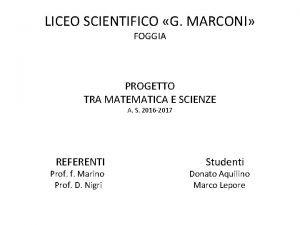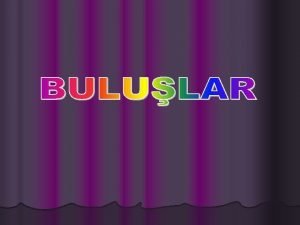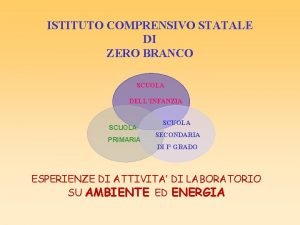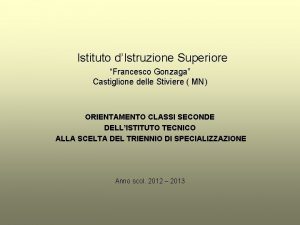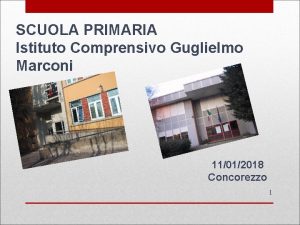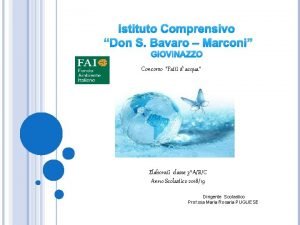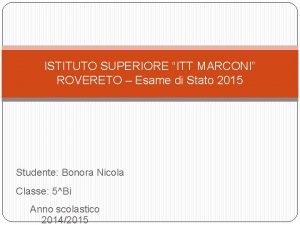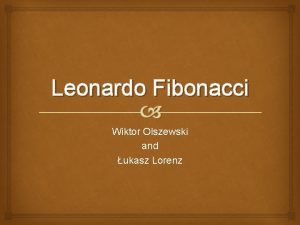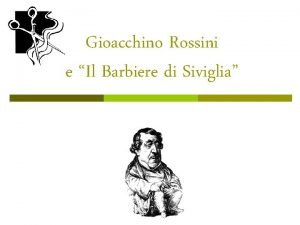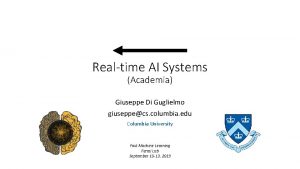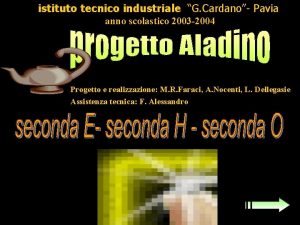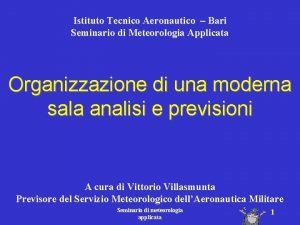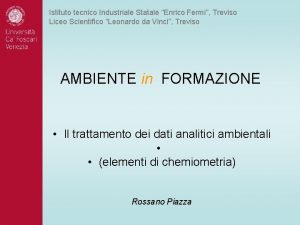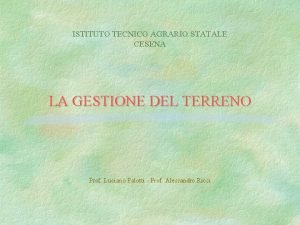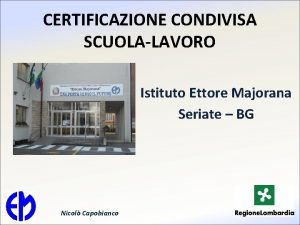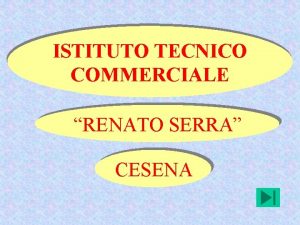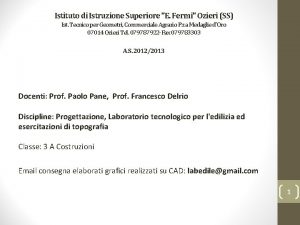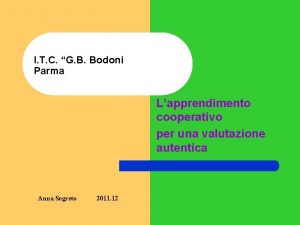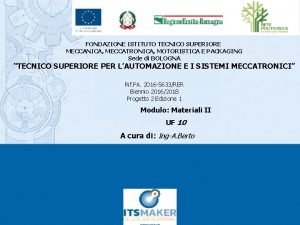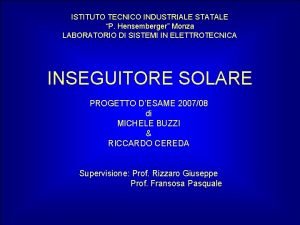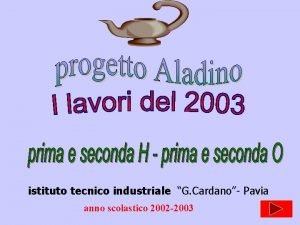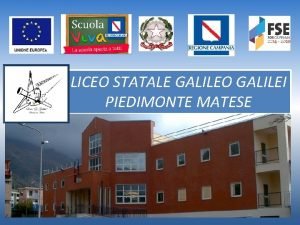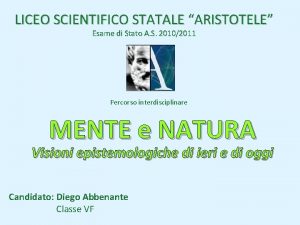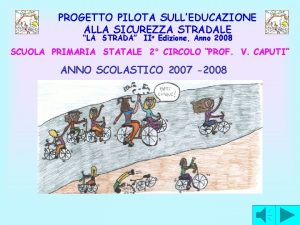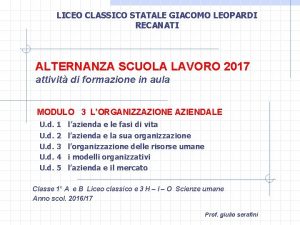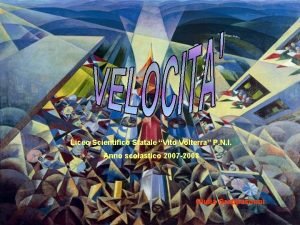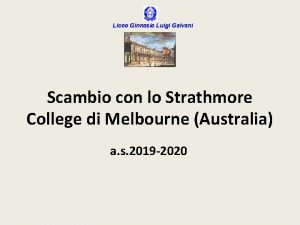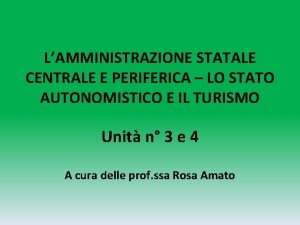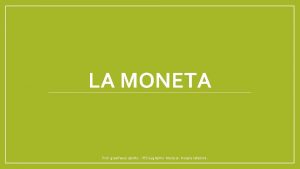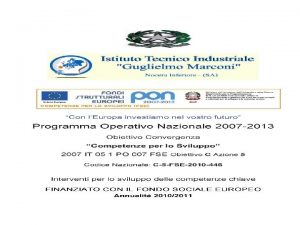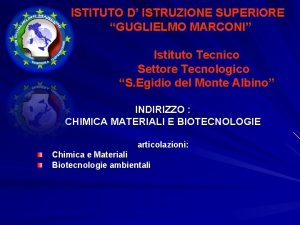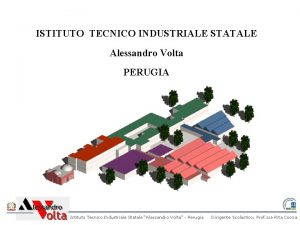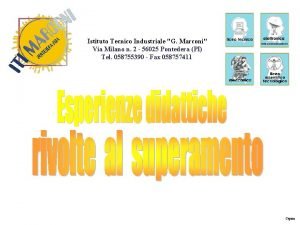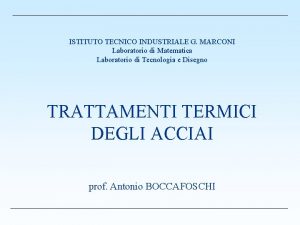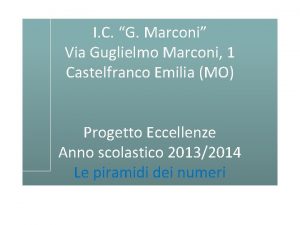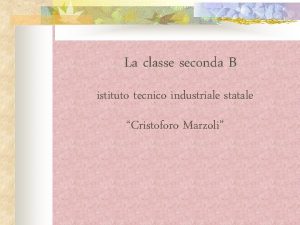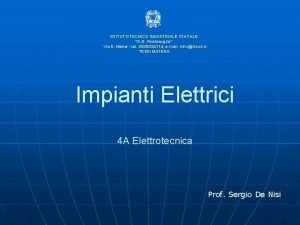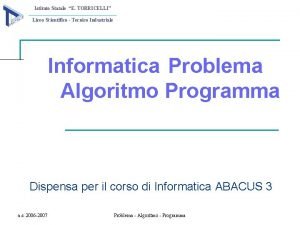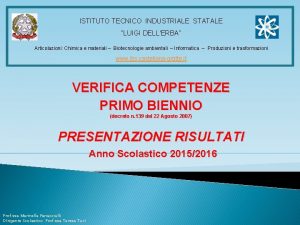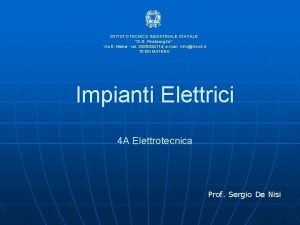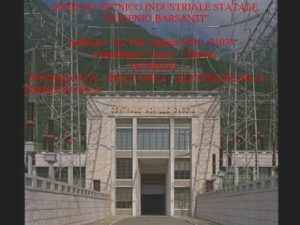ISTITUTO TECNICO INDUSTRIALE STATALE GUGLIELMO MARCONI Forl School



























![Istituto Tecnico Industriale Statale “G. Marconi” - Forlì Diagrams characteristics Amplitude: B=[f. C, ] Istituto Tecnico Industriale Statale “G. Marconi” - Forlì Diagrams characteristics Amplitude: B=[f. C, ]](https://slidetodoc.com/presentation_image_h2/ef46bfdbe0bacd76191a172f5898fa88/image-28.jpg)






















- Slides: 50

ISTITUTO TECNICO INDUSTRIALE STATALE GUGLIELMO MARCONI - Forlì School Year 2009/2010 C. L. I. L. MODULE: ANALYSIS AND DESIGN OF FIRST ORDER RC FILTERS Subjects: ELECTRONICS/ENGLISH Teachers: Miria Bovino and Roberto Versari Class: 4 AEL

Istituto Tecnico Industriale Statale “G. Marconi” - Forlì Outline of the CLIL module Lesson 1: RC low pass filter schematic and transfer function (with C. A. D. example) Lesson 2: frequency response graphical representation (with excel example) Lesson 3: Analysis of the CR high-pass filter (with excel + C. A. D. example) Lesson 4: An introduction to active filters and circuit simulations (with C. A. D. example)

Istituto Tecnico Industriale Statale “G. Marconi” - Forlì Lesson 1: RC low pass filter schematic and transfer function (2 h) Lesson 1 Targets: Learn how to draw the schematic of an RC low-pass filter. Learn how to calculate its transfer function G(jw) Learn the filter constant time ( ) definition Learn how to calculate the RC low-pass filter output for any sinusoidal input. Learn how to realize an RC low pass filter with a C. A. D. tool

Istituto Tecnico Industriale Statale “G. Marconi” - Forlì RC low pass filter schematic The first order passive RC low pass filter is made of only two components: R VI(jw) stimulus or input sinusoidal voltage C VO(jw) output sinusoidal voltage VI and VO can be represented by the corresponding vector quantities: VI=VIej I, VO= VOej O

Istituto Tecnico Industriale Statale “G. Marconi” - Forlì Transfer function calculation (1/2) The RC low pass filter can be easily seen as a simple impedance divider with Z 1=R and Z 2=1/jw. C Z 1=R VI(jw) Z 2=1/jw. C VO(jw) The impedance divider formula provides: VO/VI=Z 2/(Z 1+Z 2). VO/VI is the transfer function G(jw) of the RC filter. Hence it is: G(jw)=Z 2/(Z 1+Z 2)

Istituto Tecnico Industriale Statale “G. Marconi” - Forlì Transfer function calculation (2/2) Let’s substitute Z 1=R and Z 2=1/jw. C in G(jw) expression R. C= [s] is defined as the time constant of the low-pass filter. Hence:

Istituto Tecnico Industriale Statale “G. Marconi” - Forlì Output calculation (1/2) G(jw) is a complex number with: Amplitude: Phase: VO=G(jw). VI can be written using complex numbers properties: VO Amplitude: VO Phase: G(jw) depends only on and f (input signal frequency)

Istituto Tecnico Industriale Statale “G. Marconi” - Forlì Output calculation (2/2) RC low-pass filter 1) 2) 3) 4) 5) V I, f =R. C sinusoidal input G(jw) V O , f sinusoidal output VI, I and f are given the filter schematic is known is calculated. f and are known G(jw) and G(jw) are calculated VO =|G(jw)|. VI is calculated O = G(jw) + I is calculated

Istituto Tecnico Industriale Statale “G. Marconi” - Forlì Output calculation example Exercise: calculate the output VO of the circuit corresponding to the given sinusoidal input VI 1) VI=1 V, I=00, f=10 KHz remember: 2) =RC=320 *50 n. F=16 s 3) |G(10 KHz)|=1/ 1+(2* *10 KHz*16 s)2 =0, 7 G(10 KHz)=-artg(2* *10 KHz*16 s)=-450 The output voltage is attenuated 4) VO=0, 7*1 V=0, 7 V of a factor of 0, 7 and delayed of 0 0 0 5) O=-45 +0 =-45 45 degrees when f=10 KHz.

Istituto Tecnico Industriale Statale “G. Marconi” - Forlì LTspice. IV CAD tool Download free from: http: //www. linear. com/designtools/software CAD tools: schematic implementation and real time simulation needed to decrease electronic circuit time to market. English language prerequisite for most CAD tools.

Istituto Tecnico Industriale Statale “G. Marconi” - Forlì Lesson 2: RC low pass filter frequency response graphical representation (2 h) Lesson 2 Targets: Learn the graphical method to calculate any filter output. Learn the low-pass filter cutoff frequency (f. C) definition, its bandwidth (Bw) and the relationship between f. C and . Learn how to read and draw first-order low pass filters amplitude diagrams in logarithmic scale. Learn how to design an RC low-pass filter for a given bandwidth and/or f. C. Learn how to draw the amplitude and phase diagrams of first-order RC low-pass filters with MS-excel.

Istituto Tecnico Industriale Statale “G. Marconi” - Forlì The graphical approach to the calculation of filter output Lesson 1 result: the filter output voltage can be derived by the knowledge of the input voltage and the analitycal calculation of the filter transfer function G(jw) – both amplitude and phase. Disadvantages of the analitycal approach: - two calculations (amplitude and phase) for each input frequency. - G(jw) analitycal expression depends on filter topology. New graphical approach: two plots, namely |G(jw)| vs. f and G(jw) vs. f are associated to each filter. The calculation of the output voltage does not need G(jw) value calculation because the values of amplitude and phase of G(jw) at the given frequency can be simply read from the two given plots of the filter.

Istituto Tecnico Industriale Statale “G. Marconi” - Forlì Amplitude and Phase diagrams G(jw) vs. f is the filter phase diagram* . |G(jw)| vs. f is the filter amplitude diagram* Examples of amplitude and phase diagrams of an RC low pass filter with R=1 K and C=1 F. *=remember that:

Istituto Tecnico Industriale Statale “G. Marconi” - Forlì Output amplitude calculation with graphical method (1/2) RC low-pass filter amplitude diagram V I, f sinusoidal input V O, f sinusoidal output 1) VI, I and f are given 2) the filter amplitude diagram value at the frequency f can be read from the plot. 3) VO =|G(jw)|. VI is easily calculated, since |G(jw)| is the value read from the plot in step 2).

Istituto Tecnico Industriale Statale “G. Marconi” - Forlì Output amplitude calculation with graphical method (2/2) Case 1): VI=1, 5 V I=00 f=100 Hz From the filter amplitude diagram at f=100 Hz we read |G(jw)| =0, 8. Hence the output voltage amplitude at f=100 Hz is VO=0, 8*1, 5 V=1, 2 V Case 2): VI=1, 5 V I=00 f=1 KHz From the filter amplitude diagram at f=1 KHz we read |G(jw)| =0, 18. Hence the output voltage amplitude at f=1 KHz is VO=0, 18*1, 5 V=0, 27 V

Istituto Tecnico Industriale Statale “G. Marconi” - Forlì Output phase calculation with graphical method (1/2) RC low-pass filter phase diagram I, f sinusoidal input O , f sinusoidal output 1) VI, I and f are given 2) the filter phase diagram value at the frequency f can be read from the plot. 3) O = G(jw)+ I is easily calculated, since G(jw) is the value read from the plot in step 2).

Istituto Tecnico Industriale Statale “G. Marconi” - Forlì Output phase calculation with graphical method (2/2) Case 1): VI=1, 5 V I=00 f=100 Hz From the filter phase diagram at f=100 Hz we read G(jw)=-350. Hence the output voltage phase at f=100 Hz is O=-350+0=-350 Case 2): VI=1, 5 V I=00 f=1 KHz From the filter phase diagram at f=1 KHz we read G(jw)=-810. Hence the output voltage phase at f=1 KHz is O=-810+0=-810 Graphical method advantages: - no need to calculate amplitude and phase: they are simply read from the plots. - it is a general approach valid for all kind of filters: it is only needed the knowledge of the amplitude and phase plots.

Istituto Tecnico Industriale Statale “G. Marconi” - Forlì Amplitude diagram analysis pass band B f. C=160 Hz stop band frequency scale is logarithmic 1) The cutoff frequency f. C is defined as the frequency value at which |G(jw)|=0, 7 In fact, all input signals with f< f. C “pass”, i. e. we can find them at the filter output without significant attenuation. On the contrary, all input signals with f> f C are “cut”, i. e. the filter output has an amplitude significantly lower than the input. 2) The filter band B is defined as the range of input frequencies for which the filter attenuation is 0, 7. In practice B=[0, f. C]. The bandwidth is the width of B=f. C-0=f. C 3) The relationship between f. C and is:

Istituto Tecnico Industriale Statale “G. Marconi” - Forlì Phase diagram analysis f. C=160 Hz frequency scale is logarithmic The cutoff frequency f. C corresponds to the frequency value at which G(jw)=-450. The filter introduces a maximum phase shift (a delay) of – 90 0. All input signals with frequencies within the filter pass band [0, f C] are delayed less than 45/(360*f)=0, 125/f. Input signals with frequencies outside the filter pass band are delayed more than 0, 125*f, with a maximum delay of 0, 25/f corresponding to the maximum phase shift of – 900.

Istituto Tecnico Industriale Statale “G. Marconi” - Forlì Why a frequency logarithmic scale? frequency log. scale frequency linear scale f. C=160 Hz 1) frequency logarithmic scale: the whole waveform is clearly outlined and the amplitude values at different frequencies can be read with reasonable accuracy 2) frequency linear scale: the amplitude values at different frequencies cannot be read so the graph is useless. The same considerations hold for the phase plot.

Istituto Tecnico Industriale Statale “G. Marconi” - Forlì Whole logarithmic scale: the Bode plot Analitycal formula for output calculation: VO = G(jw). VI Normalization (dimensionless): VO/1 V= G(jw). VI/1 V logarithmic: 20 Log(VO/1 V)=20 Log G(jw) +20 Log(VI/1 V) Output calculation in d. B: VO[d. BV]= G(jw) [d. B]+VI[d. BV] f. C=160 Hz 20 d. B 1 dec |G(jw)|[d. B] vs. f is Bode plot It is a full log. diagram. f=f. C |G(jw)|=-3 d. B (in fact, 20 Log(0, 7)=-3 d. B). When f>f. C Bode plot slope is 20 d. B/dec.

Istituto Tecnico Industriale Statale “G. Marconi” - Forlì Bode plot representation advantages Very simple output calculation: VO=|G(jw)|+VI [d. B] (only a sum) Very easy to draw!!! it can be approximated by: |G(jw)|=0 for f<f. C horizontal line |G(jw)|=-20*Log(f/f. C) straight line with slope -20 d. B/dec |G(jw)| [d. B] 0 d. B -20 d. B -40 d. B -60 d. B f. C 100 f. C 1000 f. C f (log) only approximation: |G|=-3 d. B and not 0 when f=f. C

Istituto Tecnico Industriale Statale “G. Marconi” - Forlì Design for a given f. C or B The design of a first order RC low pass filter for a given f C or B is very simple: 1) calculate the filter time constant: 2) Choose a capacitor value among those available in the laboratory: for instance, C=1 F. 3) calculate the corresponding value of R: 4) if R is in the [100, 100 K] range OK!!!, otherwise go back to point 2) choosing another C value. Example: design a low pass filter with f. C=1 KHz. 1) 2) 3) 4) OK!!!

Istituto Tecnico Industriale Statale “G. Marconi” - Forlì How to use MS-excel to draw Amplitude and Phase diagrams Electronic sheet tools are useful for automated calculations and diagram representations very useful for transfer function plot drawings.

Istituto Tecnico Industriale Statale “G. Marconi” - Forlì Lesson 3: Analysis of the CR high-pass filter (2 h) Lesson 3 Targets: Learn the schematic of a high-pass CR filter and its transfer function G(jw) Learn how to draw the amplitude and phase plots of the filter Learn the relationship between , f. C and B of the filter Learn how to calculate the output of the filter Learn how to design the filter Learn how to simulate the filter with CAD tools in English language.

Istituto Tecnico Industriale Statale “G. Marconi” - Forlì CR high pass filter schematic First-order passive CR high-pass filter schematic: VI(jw) VI=VIej i Same schematic as the RC low pass filter but with R and C interchanged. VO(jw) =RC=0, 16 ms same formula as VO=VOej o the low pass filter Using the same impedance divider model: G(jw)=VO(jw)/VI(jw)=Z 2/(Z 1+ Z 2), where Z 1=1/jw. C and Z 2=R. After a few mathematics we get:

Istituto Tecnico Industriale Statale “G. Marconi” - Forlì Amplitude and Phase diagrams |G(f. C)| = -3 d. B B=[f. C, ] G(fc)=+450 20 d. B 1 dec f. C=1 KHz f. C and B are defined in the same way as the RC low pass. However, B=[f. C, ] because the filter attenuates only the frequencies < f. C, significantly.
![Istituto Tecnico Industriale Statale G Marconi Forlì Diagrams characteristics Amplitude Bf C Istituto Tecnico Industriale Statale “G. Marconi” - Forlì Diagrams characteristics Amplitude: B=[f. C, ]](https://slidetodoc.com/presentation_image_h2/ef46bfdbe0bacd76191a172f5898fa88/image-28.jpg)
Istituto Tecnico Industriale Statale “G. Marconi” - Forlì Diagrams characteristics Amplitude: B=[f. C, ] because signals are not attenuated when f>f C. Bw=. |G(f. C)|=-3 d. B (corresponding to a 0, 7* attenuation) when f<f. C |G(f)| increases of 20 d. B for each decade of increase of f (i. e. for a frequency increase of a factor of 10). Phase: f<<f. C maximum phase shift of +900, corresponding to an output voltage anticipated of 0, 25/f with respect to input. f=f. C G=+450; output voltage anticipated of 0, 125/f. C. f>>f. C G=00; output is in phase with input. High-pass: input high frequencies are not attenuated nor shifted “pass”. Input low frequencies are attenuated anticipated “cut”. f. C is the frequency cut threshold.

Istituto Tecnico Industriale Statale “G. Marconi” - Forlì Filter design and Bode plot drawing The filter design for a given f. C can be done using the same 4 steps algorithm as the low pass filter: 1) calculate the filter time constant: 2) Choose a capacitor value among those available in the laboratory: for instance, C=1 F. 3) calculate the corresponding value of R: 4) if R [100, 100 K] OK!!!, otherwise go back to point 2) choosing another C value available. |G(jw)| [d. B] 0, 01 f. C 0, 1 f. C 0 d. B -20 d. B -40 d. B -60 d. B 0, 001 f. C f (log) Bode plot drawing: |G(jw)|=0 for f>f. C horizontal line |G(jw)|=20*Log(f/f. C) straight line with slope +20 d. B/dec when f<f. C only approx. |G(f. C)|=-3 d. B and not 0 d. B.

Istituto Tecnico Industriale Statale “G. Marconi” - Forlì Output calculation examples CR high pass filter with amplitude and phase diagrams of slide 27. VO[d. BV]=|G(f)|[d. B]+VI[d. BV] O= G(f)+ I Case 1): VI=1 V=0 d. BV I=00 f=100 Hz G(100 Hz)=830. |G(100 Hz)|=-20 d. B VO=-20 d. B+0 d. BV=-20 d. BV=0, 1 V O=830+00=830 Case 2): VI=1 V=0 d. BV I=00 f=1000 Hz=1 KHz G(1 KHz)=450. |G(1 KHz)|=-3 d. B VO=-3 d. B+0 d. BV=-3 d. BV=0, 7 V O=450+00=450 Case 3): VI=1 V=0 d. BV I=00 f=10000 Hz=10 KHz G(10 KHz)=70. |G(10 KHz)|=-0, 09 d. B VO=-0, 09 d. B+0 d. BV=-0, 09 d. BV=0, 99 V O=70+00=70

Istituto Tecnico Industriale Statale “G. Marconi” - Forlì Circuit simulation: LTspice. IV download free from http: //www. linear. com/designtools/software/

Istituto Tecnico Industriale Statale “G. Marconi” - Forlì Pros and cons of simulation Simulation advantages: Fast time to market: you do not need to wait physical implementation of the circuit to know its behavior No hand calculations no human error, no interconnection errors Simulation drawbacks: If components models are not accurate the circuit can exhibit unexpected behavior Parasitic components are not included and are circuit layout dependent difficult to predict. That’s what differentiates the good from the bad designer. The Pros are exceedingly better than the Cons: that’s why simulation is ALWAYS used to prototype new designs.

Istituto Tecnico Industriale Statale “G. Marconi” - Forlì Lesson 4: An introduction to active filters and simulation examples (2 h) Lesson 4 Targets: Learn the main differences between RC passive and active filters. Learn the schematics of low-pass and high-pass RC active filters. Learn the amplitude and phase diagrams of active filters. Learn the schematic and the frequency response diagrams of the pass-band second order RC active filter. Learn how to simulate active filters. Learn some practical applications of filters. Learn the difference between first-order and higher order filters.

Istituto Tecnico Industriale Statale “G. Marconi” - Forlì Passive vs. active filters Let’s consider an RC low pass filter connected to a 1 K load RL: VI(jw) VI=VIej i VO(jw) VO=VOej o The effect of RL is to change Z 2: Z 2=C//RL=RL/(1+jw. CRL) Consequently G(jw) changes too and becomes: Consequences: 1) Maximum amplitude = 1+R/RL <1 2) f. C = (1+R/RL)/2

Istituto Tecnico Industriale Statale “G. Marconi” - Forlì Limits of passive filters The main limits of passive filters are: 1) the frequency response of the filter is dependent on the RL load. In particular, the maximum amplitude of the filter when connected to a load is <1 and load dependent. f. C value is load dependent too. 2) the maximum amplitude of a passive filter is =1 (no signal gain) even when not connected to any RL load. Active filters are able to provide both a frequency response independent of any RL load and a signal gain >1. They are obtained adding an active component such as an OP. AMP. (OPerational AMPlifier) to a passive filter.

Istituto Tecnico Industriale Statale “G. Marconi” - Forlì First order low-pass active filter Schematic: Inverting amplifier configuration G(jw)=-Z 2/Z 1 where Z 1=R 1=159 and Z 2=C//R 2=R 2/(1+jw 2), 2=C*R 2=0, 159 ms Advantages: G(jw) independent of any RL (>100 ) connected to filter output VO because of the low OPAMP output resistance Programmable low frequency gain = R 2/R 1

Istituto Tecnico Industriale Statale “G. Marconi” - Forlì low-pass active filter frequency response |G(f. C)|=17 d. B f. C=1 KHz G(f. C)=1350 Amplitude: Same diagram as passive filter shifted up of 20*Log(R 2/R 1) Phase: Same diagram as passive filter shifted up of 180 0 f. C is the frequency at which |G| is – 3 d. B with respect to its low frequency value (same definition used for amplifiers): |G(f. C)|=|G(0)|-3 d. B. When f= f. C G(f. C) = G(0) – 450

Istituto Tecnico Industriale Statale “G. Marconi” - Forlì First order high-pass active filter Schematic: G(jw)=-Z 2/Z 1 where Z 2=R 2=1, 59 K and Z 1=R 1+1/jw. C=(1+jw 1)/jw. C, 1=C*R 1=0, 159 ms 2=C*R 2=1, 59 ms High frequency gain = 2/ 1=R 2/R 1 Independent of load RL (if RL>100 )

Istituto Tecnico Industriale Statale “G. Marconi” - Forlì high-pass active filter frequency response |G(f. C)|=17 d. B f. C=1 KHz G(f. C)=2250 Amplitude: Same diagram of passive filter shifted up of 20*Log(R 2/R 1) Phase: Same diagram of passive filter shifted up of 180 0 f. C is the frequency at which |G| is – 3 d. B with respect to its high frequency value: |G(f. C)|=|G(f= )|-3 d. B. When f= f. C G(f. C) = G(0) – 450

Istituto Tecnico Industriale Statale “G. Marconi” - Forlì What’s a pass-band active filter? Low-pass filter: only low frequency inputs are not attenuated. High-pass filter: only high frequency inputs are not attenuated. Pass-band only frequency inputs [f 1, f 2] are not attenuated. B=[f 1, f 2] is the pass-band of the filter. Simpler pass-band filter: cascade of low-pass + high-pass filters: f. C 1 f. C 2 OUTPUT INPUT low-pass high-pass SIGNAL with f. C=f. C 1 with f. C=f. C 2 frequencies above f. C 1 are attenuated frequencies above f. C 1 and below f. C 2 are attenuated Works only if f. C 2>f. C 1; It doesn’t matter if low-pass is first or second in the cascade if they are active filters.

Istituto Tecnico Industriale Statale “G. Marconi” - Forlì Second order pass-band active filter Schematic: G(jw)=-Z 2/Z 1 where Z 2=R 2//C 2=R 2/(1+ jw 2) Z 1=R 1+1/jw. C 1=(1+jw 1)/jw. C 1, 1=C 1*R 1=30 s 2=C 2*R 2=9. 54 s 12=C 1*R 2=47, 7 s Filter pass-band B=[f. C 1, f. C 2], with f. C 1<f. C 2:

Istituto Tecnico Industriale Statale “G. Marconi” - Forlì Pass-band active filter frequency response f. C 1=5, 3 K f. C 2=16, 7 K G(f. C 1)=2050 G(f. C 2)=1550 The Bode plot of the pass-band active filter is exactly the sum of the Bode plots of the low-pass and high-pass active filters with the same 2 and 1, respectively. The phase diagram of the pass-band active filter is the sum decreased of 1800 of the phase diagrams of the low-pass and high-pass active filters with the same 2 and 1, respectively.

Istituto Tecnico Industriale Statale “G. Marconi” - Forlì Filter simulation: passive vs. active C 1 C 2 The RL load does not affect active filter response while it affects both amplitude and phase response of the passive filter. Without RL the two responses are the same.

Istituto Tecnico Industriale Statale “G. Marconi” - Forlì Filter simulation: pass-band C 1 C 2 Average value of input square waveform “cut”. High frequency components “cut” too. Output is almost sinusoidal (depends on filter selectivity).

Istituto Tecnico Industriale Statale “G. Marconi” - Forlì Filter applications: ADSL modem 6 th order low-pass You can phone while browsing the Internet!!! The phone signal doesn’t disturb the ADSL signal because of the high-pass filter embedded in the ADSL module. The ADSL signal doesn’t disturb the phone signal because of the low-pass filter inserted just before the phone receiver.

Istituto Tecnico Industriale Statale “G. Marconi” - Forlì Filter applications: audio systems audio signal [0, 20 KHz] cross-over low-pass [0, 3 KHz] woofer (bass) cross-over high-pass [3 K, 20 K] tweeter (high) A Hi-Fi (High Fidelity) audio system is composed of at least two different speakers: a woofer to reproduce bass sounds and a tweeter for the high sounds. A cross-over filter is placed before each speaker so that the speaker can be reached only by the frequency components of the input audio signal it is able to reproduce. Cross-over filters are typically 2 nd or 3 rd order lowpass or high-pass filters.

Istituto Tecnico Industriale Statale “G. Marconi” - Forlì Higher order filters. In practical applications 2 nd or higher order filters are typically used because of their higher selectivity: |G(jw)| [d. B] 0 d. B Note: the order of a filter is equal to the number of reactive -20 d. B components in its schematic (i. e. the -40 d. B number of poles of its -60 d. B transfer function). f. C 100 f. C 1000 f. C 1 st f (log) order: -20 d. B/dec 2 nd order: -40 d. B/dec 3 rd order: -60 d. B/dec Low-pass filter attenuation at f=10*f. C is: 1 st order 0. 1 2 nd order 0. 01 3 rd order 0. 001 The higher the order of the filter the better its ability to select only the frequencies within its pass band B.

Istituto Tecnico Industriale Statale “G. Marconi” - Forlì Bibliography (1/3) The following list of references can be used for an in-depth investigation of the subject of the presentation: 1. The Analysis and Design of Linear Circuits, 6 th Edition, R. E. Thomas, A. J. Rosa, G. J. Toussaint, ISBN: 978 -0 -470 -38330 -8, 2009. (basic textbook on linear circuits analysis with a complete chapter on AC analysis and Bode plots of analog filters). 2. http: //www. animations. physics. unsw. edu. au/jw/RCfilters. html (basic analysis of RC filters with animations). 3. http: //www. play-hookey. com/ac_theory/filter_basics. html (basic theory of active and passive filters). 4. http: //www. educypedia. be/electronics/analogfil. htm (link to several resources on analog filters, both passive and active).

Istituto Tecnico Industriale Statale “G. Marconi” - Forlì Bibliography (2/3) http: //www. usna. edu/Users/ee/kintzley/ee 303 sp 09/lectures/EE 303 S 5. p 09_L 05_Filters. pdf (lecture on basic filter topologies and solutions). 6. http: //dev. emcelettronica. com/performing-ac-analysis-ltspice (method to perform an AC analysis of an RC filter with Ltspice) http: //www. swarthmore. edu/Nat. Sci/echeeve 1/Ref/Data. Sheet/Int 7. ro. To. Filters. pdf (basic introduction to analog filters from National Semiconductor Corp. , with examples of real analog filters IC's and criteria to select among filter topologies). 8. Active Filter Cookbook, D. Lancaster, 2 nd ed. Thatcher, Synergetics Press, 1995 (a comprehensive textbook on active filter design and analysis)

Istituto Tecnico Industriale Statale “G. Marconi” - Forlì Bibliography (3/3) 9. http: //www. wisc-online. com/objects/index_tj. asp? obj. ID=ACE 2803 (analysis of the bode plots of an RC low pass filter). 10. http: //www. che. ttu. edu/pcoc/software/ppt/Chap 09. ppt (chapter on Bode plot analysis of linear systems with stability criteria). 11. http: //eprints. iisc. ernet. in/13500/1/lec_5_web. pdf (lecture on Bode plots and second order linear systems)
 Istituto marconi foggia
Istituto marconi foggia Radyoyu icat eden kimdir
Radyoyu icat eden kimdir Scuola marconi zero branco
Scuola marconi zero branco Istituto gonzaga castiglione delle stiviere
Istituto gonzaga castiglione delle stiviere Scuola mascagni calenzano
Scuola mascagni calenzano Istituto comprensivo marconi concorezzo
Istituto comprensivo marconi concorezzo Ic bavaro marconi
Ic bavaro marconi Istituto marconi rovereto
Istituto marconi rovereto Ic sasso marconi
Ic sasso marconi Fibonacci guglielmo bonacci
Fibonacci guglielmo bonacci Il barbiere di siviglia trama
Il barbiere di siviglia trama Giuseppe di guglielmo
Giuseppe di guglielmo Guglielmo volpe
Guglielmo volpe Penemu barisan fibonacci
Penemu barisan fibonacci Iscrizione motti reggio emilia
Iscrizione motti reggio emilia Istituto cardano milano
Istituto cardano milano Liceo aeronautico bari
Liceo aeronautico bari Istituto tecnico per il turismo livia bottardi
Istituto tecnico per il turismo livia bottardi Istituto tecnico fermi treviso
Istituto tecnico fermi treviso Vittorio emanuele bergamo
Vittorio emanuele bergamo Elenco docenti zanon udine
Elenco docenti zanon udine Istituto tecnico agrario cesena
Istituto tecnico agrario cesena Itis ettore majorana avezzano
Itis ettore majorana avezzano Istituto federico cesi terni
Istituto federico cesi terni Istituto tecnico torricelli milano
Istituto tecnico torricelli milano Istituto majorana seriate
Istituto majorana seriate Itc cesena
Itc cesena Iis fermi ozieri
Iis fermi ozieri Istituto bodoni parma
Istituto bodoni parma Istituto tecnico meccatronica bologna
Istituto tecnico meccatronica bologna Scuola deffenu olbia
Scuola deffenu olbia Hensemberger monza
Hensemberger monza Liceo cardano milano
Liceo cardano milano Scuola jacopo barozzi modena
Scuola jacopo barozzi modena Istituto tecnico majorana grugliasco
Istituto tecnico majorana grugliasco Liceo scientifico galileo galilei piedimonte matese
Liceo scientifico galileo galilei piedimonte matese Liceomontanari.it
Liceomontanari.it Liceo scientifico statale aristotele
Liceo scientifico statale aristotele Liceo statale galileo galilei voghera
Liceo statale galileo galilei voghera Strada statale
Strada statale Liceo linguistico dolo
Liceo linguistico dolo Liceo recanati scienze umane
Liceo recanati scienze umane Scuola media statale virgilio marone
Scuola media statale virgilio marone Lombardo radice catania
Lombardo radice catania Il futurismo
Il futurismo Liceo scienze umane dolo
Liceo scienze umane dolo Liceo ginnasio luigi galvani
Liceo ginnasio luigi galvani Amministrazione statale periferica
Amministrazione statale periferica Eugene marconi
Eugene marconi Pediatra natali sasso marconi
Pediatra natali sasso marconi Gianfranco celotto
Gianfranco celotto
